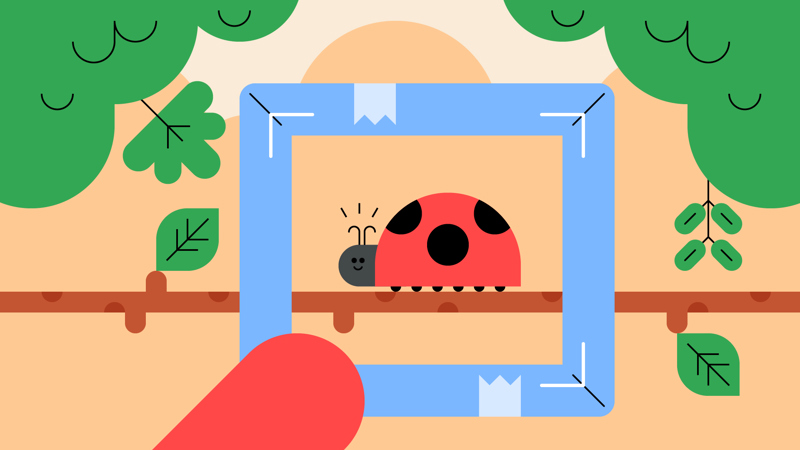
Make a cardboard viewfinder
You’ll need
- Scissors
- Camera or phone
- A4 card
- Pens or pencils
Before you begin
- Use the safety checklist to help you plan and risk assess your activity. There's also more guidance to help you carry out your risk assessment, including examples.
- Make sure all young people and adults involved in the activity know how to take part safely.
- Make sure you’ll have enough adult helpers. You may need some parents and carers to help if you’re short on helpers.
Make the cardboard frames
- Gather everyone together and tell them you’re going to make view finders to capture nature.
- Ask everyone to think of a shape. It could be a butterfly, a music note, a squirrel, a star, a rectangle or something else.
- Everyone should take a piece of paper or thin cardboard, such as one side of a cereal box.
- Use a pencil to draw out the shape on the paper or card.
- Next, carefully cut out the shape with scissors and the viewfinder is ready.
- To make a simple viewfinder, fold the paper or card in half, then draw a rectangle from the folded edge, but leave a border around it that’s about 3cm wide. Cut their rectangle out with scissors and open up the paper to reveal their viewfinder.
Snap some photos
- Once everyone’s made their viewfinder, gather everyone together. For younger groups, you could talk about the shapes and what it was like making them.
- Now, ask everyone to think about what you need to do to take a photo and what makes a good photo.
- You could talk about choosing your subject and framing the shot, or lighting the photo.
- Next, head outside or into a green space. You may wish to go on a short walk. Everyone should explore using their viewfinders, framing and ‘taking pictures of’ things and people that look interesting.
- If people have made a certain shape, such as a fox, can they find something red or orange to hold the viewfinder over and make it look like an actual fox?
- Using a camera, everyone should take it in turns to try out taking a photo of a view they’ve framed with their viewfinder.
- Once you’ve finished, gather everyone back together and talk about the photos you’ve taken.
Photography tips
Some top photography tips are:
- Search for something interesting: Keep an eye out for interesting shapes, colours, and textures to photograph.
- Pick a subject: Choose what you’re going to photograph (this is called your ‘subject’) and decide if you want to take a picture of all or part of it.
- Find your framing: Move the frame around until you’re happy with how it looks. Get the right distance away from the subject. Are you close enough? You may need to stand, sit, or lie to find the best angle.
- Know about foreground and background: The foreground is the part of a view that is nearest to the observer, especially in a picture or photograph. The background is the part of a picture that forms a setting for the main figures or objects, or appears furthest from the viewer.Find a good background for your photo —do you want it to be busy and colourful, or would that be too distracting? You may want to use something on the foreground (at the front of the picture) to ‘frame’ a photo or the background, such as the branch of a tree, a window, or a doorway. Why not try different backgrounds to see what looks best?
- Let lots of light in: Look at where the light’s coming from and move the frame around until you’re happy with how it looks. Try to keep the light source to the side or behind you. Take the picture outside if you can.
- Keep still: Hold the camera steady, and press the button gently. Make sure the camera doesn’t move as you press.
- Be creative: Experiment with your own ideas—if it doesn’t quite work, it’s OK. Just try again!
- Taking photos of people: Decide if you want to take a picture of their face (this is a portrait) or their whole body. You may wish to ask them to strike a pose and stay still while you take the photo. If you’re taking a group photo, ask the people to stand or sit in different positions—think about how you can fit them all in to the frame.
- Take a second photo: It’s often a good idea to take another one so you can choose which one is best. Always take another picture, just in case they closed their eyes!
Reflection
This activity helped you develop skills, including photography. What was the most important thing you learned about taking a photo? What was the best way to get a great shot? Once you’ve had a think, talk about your answers with a partner. Maybe you could think about holding the camera steady, keeping the light behind you, or finding a good background. How did it feel to learn a new skill (or get better at a skill you had)?
Now you’ve worked on your photography skills, how are you going to use them? What would you like to take a picture of? Take it in turns to share your answers with a partner, or the whole group. Like any skill, the more you practice, the better you’ll get, so why not try taking that photo at home (you can ask a parent or carer to help)?
Safety
All activities must be safely managed. You must complete a thorough risk assessment and take appropriate steps to reduce risk. Use the safety checklist to help you plan and risk assess your activity. Always get approval for the activity, and have suitable supervision and an InTouch process.
- Scissors
Supervise young people appropriately when they’re using scissors. Store all sharp objects securely, out of the reach of young people.
- Phones and cameras
Make sure parents and carers are aware and have given consent for photography.
- Sharp objects
Teach young people how to use sharp objects safely. Supervise them appropriately throughout. Store all sharp objects securely, out of the reach of young people.
- Outdoor activities
You must have permission to use the location. Always check the weather forecast, and inform parents and carers of any change in venue.
- Visits away from your meeting place
Complete a thorough risk assessment and include hazards, such as roads, woodland, plants, animals, and bodies of water (for example, rivers, ponds, lakes, and seas). You’ll probably need more adult helpers than usual. Your risk assessment should include how many adults you need. The young people to adult ratios are a minimum requirement. When you do your risk assessment, you might decide that you need more adults than the ratio specifies. Think about extra equipment that you may need to take with you, such as high visibility clothing, a first aid kit, water, and waterproofs. Throughout the activity, watch out for changes in the weather and do regular headcounts.
- Hiking and walking
Follow the guidance for activities in Terrain Zero, or the guidance for each the adventurous activity.
People may need some help making their frames. You could make them in advance or have templates for people to draw around.
It’s up to you how much detail you go into about things, such as lighting and taking pictures of people – you can keep it simple, or increase the challenge.
Anyone who has a visual impairment can describe what they’d like to frame with their viewfinder (or photograph with the camera). Someone should help them frame or photograph, describe what they can see, and ask questions (for example: ‘at the moment the photo doesn’t show the person’s feet—should they be in the picture?’)
All Scout activities should be inclusive and accessible.
